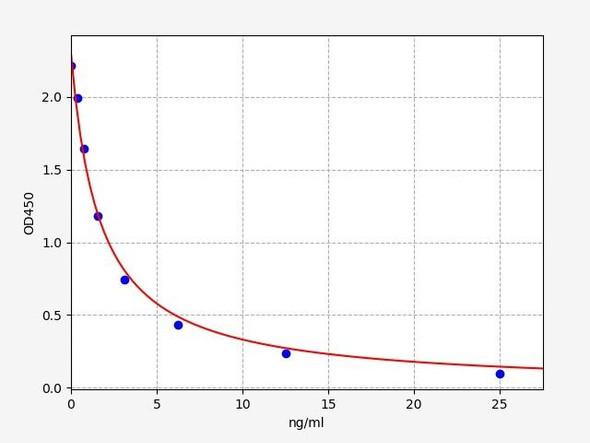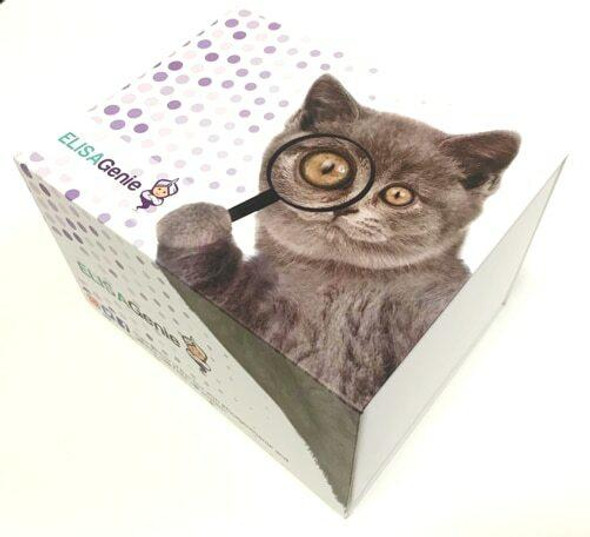Mouse COR(Cortisol) ELISA Kit
- SKU:
- MOFI01342
- Product Type:
- ELISA Kit
- Size:
- 96 Assays
- Sensitivity:
- 0.234ng/ml
- Range:
- 0.391-25ng/ml
- ELISA Type:
- Competitive
- Synonyms:
- Cortisol
- Reactivity:
- Mouse
Description
Kit Name
Cortisol, a vital hormone belonging to the glucocorticoid class, plays a crucial role in regulating various physiological processes in mammals. The Mouse Cortisol ELISA kits provide researchers and clinicians with a reliable tool to quantitatively assess cortisol concentrations in a wide range of applications.
Key Features
| Save Time | Pre-coated 96 well plate | |
| Quick Start | Kit includes all necessary reagents | |
| Publication Ready | Reproducible and reliable results |
Overview
|
Product Name: |
Mouse COR(Cortisol) ELISA Kit |
|
Product Code: |
MOFI01342 |
|
Size: |
96 Assays |
|
Alias: |
Cortisol |
|
Detection Method: |
Competitive ELISA |
|
Application: |
This immunoassay kit allows for the in vitro quantitative determination of Mouse COR concentrations in serum plasma and other biological fluids. |
|
Sensitivity: |
0.234ng/ml |
|
Range: |
0.391-25ng/ml |
|
Storage: |
4°C for 6 months |
|
Note: |
For Research Use Only |
Additional Information
|
Recovery |
Matrices listed below were spiked with certain level of Mouse COR and the recovery rates were calculated by comparing the measured value to the expected amount of Mouse COR in samples. Not Available |
|
Linearity: |
The linearity of the kit was assayed by testing samples spiked with appropriate concentration of Mouse COR and their serial dilutions. The results were demonstrated by the percentage of calculated concentration to the expected. Not Available |
|
Intra Assay |
CV < 8% |
|
Inter Assay |
CV < 10% |
Kit Components
| Component | Quantity | Storage |
|
ELISA Microplate (Dismountable) |
8x12 strips |
4°C for 6 months |
|
Lyophilized Standard |
2 |
4°C/ -20°C |
|
Sample/Standard Dlution Buffer |
20ml |
4°C |
|
Biotin-labeled Antibody (Concentrated) |
60ul |
4°C (Protection from light) |
|
Antibody Dilution Buffer |
10ml |
4°C |
|
HRP-Streptavidin Conjugate (SABC) |
120ul |
4°C (Protect from light) |
|
SABC Dilution Buffer |
10ml |
4°C |
|
TMB Substrate |
10ml |
4°C (Protection from light) |
|
Stop Solution |
10ml |
4°C |
|
Wash Buffer (25X) |
30ml |
4°C |
|
Plate Sealer |
5 |
- |
Other materials required:
- Microplate reader with 450 nm wavelength filter
- Multichannel Pipette, Pipette, microcentrifuge tubes and disposable pipette tips
- Incubator
- Deionized or distilled water
- Absorbent paper
- Buffer resevoir
Protocol
*Note: Protocols are specific to each batch/lot. For the correct instructions please follow the protocol included in your kit.
Equilibrate the TMB substrate for at least 30 min at 37°C beforeuse. When diluting samples and reagents, they must be mixed completely andevenly. It is recommended to plot a standard curve for each test.
| Step | Procedure |
|
1. |
Set standard, test sample and control (zero) wells on the pre-coatedplate respectively, and then, record their positions. It isrecommended to measure each standard and sample in duplicate. Washplate 2 times before adding standard, sample and control (zero) wells! |
|
2. |
Add Sample and Biotin-detection antibody: Add 50µL of Standard, Blank or Sample per well. The blankwell is added with Sample Dilution Buffer. Immediately add 50 µL of biotin-labelled antibody workingsolution to each well. Cover with the plate sealer provided. Gently tap the plate to ensure thoroughmixing. Incubate for 45 minutes at 37°C. (Solutions are added to the bottom of micro-ELISA platewell, avoid touching plate walls and foaming). |
|
3. |
Wash: Aspirate each well and wash, repeating the process three timesWash by filling each well with Wash Buffer (approximately 350µL)using a squirt bottle, multi-channel pipette, manifold dispenser orautomated washer. Complete removal of liquid at each step is essentialto good performance. After the last wash, remove any remaining WashBuffer by aspirating or decanting. Invert the plate and pat it againstthick clean absorbent paper. |
|
4. |
HRP-Streptavidin Conjugate(SABC): Add 100µL of SABC workingsolution to each well. Cover with a new Plate sealer. Incubate for30minutes at 37°C. |
|
5. |
Wash: Repeat the aspiration/wash process for five times. |
|
6. |
TMB Substrate: Add 90µL of TMB Substrate to each well. Coverwith a new Plate sealer. Incubate for about 10-20 minutes at 37°C.Protect from light. The reaction time can be shortened or extendedaccording to the actual color change, but not more than 30minutes.When apparent gradient appeared in standard wells, you can terminatethe reaction. |
|
7. |
Stop: Add 50µL of Stop Solution to each well. Color turn toyellow immediately. The adding order of stop solution should be as thesame as the substrate solution. |
|
8. |
OD Measurement: Determine the optical density (OD Value) of each wellat once, using a microplate reader set to 450 nm. You should open themicroplate reader ahead, preheat the instrument, and set the testing parameters. |
Sample Preparation
When carrying out an ELISA assay it is important to prepare your samples in order to achieve the best possible results. Below we have a list of procedures for the preparation of samples for different sample types.
| Sample Type | Protocol |
|
Serum |
If using serum separator tubes, allow samples to clot for 30 minutes at room temperature. Centrifuge for 10 minutes at 1,000x g. Collect the serum fraction and assay promptly or aliquot and store the samples at -80°C. Avoid multiple freeze-thaw cycles. If serum separator tubes are not being used, allow samples to clot overnight at 2-8°C. Centrifuge for 10 minutes at 1,000x g. Remove serum and assay promptly or aliquot and store the samples at -80°C. Avoid multiple freeze-thaw cycles. |
|
Plasma |
Collect plasma using EDTA or heparin as an anticoagulant. Centrifuge samples at 4°C for 15 mins at 1000 × g within 30 mins of collection. Collect the plasma fraction and assay promptly or aliquot and store the samples at -80°C. Avoid multiple freeze-thaw cycles. Note: Over haemolysed samples are not suitable for use with this kit. |
|
Urine & Cerebrospinal Fluid |
Collect the urine (mid-stream) in a sterile container, centrifuge for 20 mins at 2000-3000 rpm. Remove supernatant and assay immediately. If any precipitation is detected, repeat the centrifugation step. A similar protocol can be used for cerebrospinal fluid. |
|
Cell culture supernatant |
Collect the cell culture media by pipette, followed by centrifugation at 4°C for 20 mins at 1500 rpm. Collect the clear supernatant and assay immediately. |
|
Cell lysates |
Solubilize cells in lysis buffer and allow to sit on ice for 30 minutes. Centrifuge tubes at 14,000 x g for 5 minutes to remove insoluble material. Aliquot the supernatant into a new tube and discard the remaining whole cell extract. Quantify total protein concentration using a total protein assay. Assay immediately or aliquot and store at ≤ -20 °C. |
|
Tissue homogenates |
The preparation of tissue homogenates will vary depending upon tissue type. Rinse tissue with 1X PBS to remove excess blood & homogenize in 20ml of 1X PBS (including protease inhibitors) and store overnight at ≤ -20°C. Two freeze-thaw cycles are required to break the cell membranes. To further disrupt the cell membranes you can sonicate the samples. Centrifuge homogenates for 5 mins at 5000xg. Remove the supernatant and assay immediately or aliquot and store at -20°C or -80°C. |
|
Tissue lysates |
Rinse tissue with PBS, cut into 1-2 mm pieces, and homogenize with a tissue homogenizer in PBS. Add an equal volume of RIPA buffer containing protease inhibitors and lyse tissues at room temperature for 30 minutes with gentle agitation. Centrifuge to remove debris. Quantify total protein concentration using a total protein assay. Assay immediately or aliquot and store at ≤ -20 °C |
|
Breast Milk |
Collect milk samples and centrifuge at 10,000 x g for 60 min at 4°C. Aliquot the supernatant and assay. For long term use, store samples at -80°C. Minimize freeze/thaw cycles. |
Cortisol Background
Cortisol Hormone
Cortisol, often referred to as the "stress hormone," is a vital component of the body's endocrine system. As a glucocorticoid hormone, cortisol plays a crucial role in regulating numerous physiological processes in humans and animals. Its intricate structure, synthesis, function, metabolism, and clinical significance make cortisol a fascinating hormone worthy of exploration.
Cortisol Structure
Structurally, cortisol belongs to the class of steroid hormones and features a distinct arrangement of four interconnected rings. This steroid structure allows cortisol to interact with specific receptors within cells, triggering various physiological responses. Synthesis of cortisol primarily occurs in the adrenal glands, located on top of the kidneys. The process begins when the hypothalamus releases corticotropin-releasing hormone (CRH), stimulating the pituitary gland to secrete adrenocorticotropic hormone (ACTH). ACTH, in turn, signals the adrenal glands to produce and release cortisol into the bloodstream.
Cortisol Function
The function of cortisol spans multiple systems within the body. It plays a critical role in the body's response to stress, regulating the fight-or-flight response and assisting in coping with challenging situations. Cortisol also influences metabolism, particularly in relation to glucose metabolism, protein breakdown, and fat storage. Furthermore, cortisol affects immune function, cardiovascular health, and the maintenance of overall homeostasis. By exerting anti-inflammatory effects, cortisol aids in suppressing the immune response and reducing inflammation in the body.
Cortisol Metabolism
Cortisol metabolism involves intricate enzymatic processes primarily occurring in the liver. It undergoes biotransformation, leading to the formation of inactive metabolites that are eventually eliminated from the body through urine or bile. Any disruptions in cortisol metabolism can have significant clinical implications. Abnormal cortisol levels are associated with various medical conditions, such as Cushing's syndrome (characterized by excessive cortisol production) and Addison's disease (marked by insufficient cortisol production)
Cortisol Blockers
In clinical practice, the measurement of cortisol levels is of paramount importance. Cortisol levels fluctuate throughout the day, following a diurnal rhythm with the highest concentrations in the morning and the lowest at night. Monitoring cortisol levels can aid in the diagnosis and management of adrenal disorders, stress-related conditions, and endocrine abnormalities. It is also utilized in assessing the functioning of the hypothalamic-pituitary-adrenal (HPA) axis, which regulates cortisol production.
In certain clinical scenarios, cortisol blockers or inhibitors may be employed. These compounds work by blocking cortisol receptors or inhibiting cortisol synthesis, aiming to modulate the effects of cortisol in specific conditions. By using cortisol blockers, researchers and healthcare professionals can explore the influence of cortisol on various physiological and pathological processes, opening doors for potential therapeutic interventions.
Mouse Cortisol ELISA Kit FAQs
Q: What is the purpose of the Mouse cortisol ELISA Kit?
The Mouse cortisol ELISA Kit is specifically designed to measure and quantify cortisol levels in mouse samples. Cortisol is a crucial hormone involved in regulating various physiological processes, including stress response, metabolism, and immune function. This kit provides researchers and clinicians with a reliable and efficient tool to accurately assess cortisol concentrations in mice for a wide range of applications, including stress studies, endocrine research, and investigations into cortisol dysregulation.
Q: What types of samples can be used with the Mouse cortisol ELISA Kit?
The Mouse cortisol ELISA Kit can be used with a variety of sample types, including plasma, serum, urine, and tissue homogenates. This versatility enables researchers and clinicians to analyze cortisol levels in different biological matrices, depending on their specific research or diagnostic needs.
Q: What is the species specificity of the Mouse cortisol ELISA Kit?
The Mouse cortisol ELISA Kit is specifically designed and optimized for the measurement of cortisol levels in mouse samples. It exhibits high specificity for mouse cortisol, allowing for accurate and reliable quantification. While this kit is tailored for mouse samples, it is important to note that it may not be suitable for measuring cortisol in samples from other species. For accurate cortisol measurements in different species, we recommend using species-specific cortisol ELISA kits tailored for those particular organisms.
Q: Where can I find additional technical support or assistance with the kit?
For any technical inquiries or assistance regarding the kit, you can reach out to our team. They will be available to answer your questions and provide the necessary guidance to ensure a successful experiment.
Related Products

| Mouse Cortisone (CRO) ELISA Kit | |
|---|---|
| ELISA Type: | Competitive |
| Size: | 96 Assays |
| Range: | 0.78-50 ng/mL |

| Mouse ACTH ELISA Kit | |
|---|---|
| ELISA Type: | Competitive |
| Sensitivity: | 9.375pg/ml |
| Range: | 15.625-1000pg/ml |

| Mouse Glucocorticoid Receptor ELISA | |
|---|---|
| ELISA Type: | Sandwich |
| Sensitivity: | 0.094ng/ml |
| Range: | 0.156-10ng/ml |






